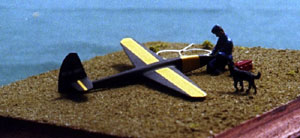"First and Final Flight"
The Slingsby Type 19 Target | |
While we modelers are for the most part spectators when it comes to
military aviation, once in a while we do make a contribution. In World
War II, for example, a model club's design for an expendable target aircraft
resulted in a training aid that helped many future RAF pilots gain an
eye for marksmanship.
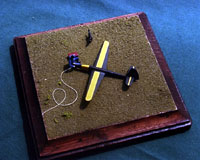 The
Slingsby Type 19 was a glider target with a 16-foot wingspan that came
into use in 1942. The last one wasn't shot from the skies until the 1950s,
giving this disposable aircraft a rather long service life. Constructed
out of wood and tissue—non-strategic materials, in other words—the Type
19 gave pilots an airplane-shaped target to fire at and gain experience
that could help when they encountered real opposition. The Type 19 was
towed behind Fireflies, Beaufighters, Tempests and less high-performance
tugs. The
Slingsby Type 19 was a glider target with a 16-foot wingspan that came
into use in 1942. The last one wasn't shot from the skies until the 1950s,
giving this disposable aircraft a rather long service life. Constructed
out of wood and tissue—non-strategic materials, in other words—the Type
19 gave pilots an airplane-shaped target to fire at and gain experience
that could help when they encountered real opposition. The Type 19 was
towed behind Fireflies, Beaufighters, Tempests and less high-performance
tugs.
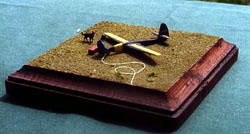 Such a small and seldom-seen aircraft seems like an unlikely subject for a kit. In 1991, Blue Rider issued a short-run white-metal 1:72 kit of the Type 19. Seven years later, I found one in the estate sale of beloved San Francisco Bay Area modeler Hugh Silvis, and it looked like a nifty little addition to my collection of odd aircraft. Such a small and seldom-seen aircraft seems like an unlikely subject for a kit. In 1991, Blue Rider issued a short-run white-metal 1:72 kit of the Type 19. Seven years later, I found one in the estate sale of beloved San Francisco Bay Area modeler Hugh Silvis, and it looked like a nifty little addition to my collection of odd aircraft.
The model comes in a bag that also contains decals for a Firefly TT.4 of 700 Squadron. It’s the epitome of a short-run kit; my example was number 168 out of a run of 1000! The Type 19 itself consists of just four parts: the fuselage, wings and tail. There are no landing gear bays and no cockpit to detail, and the parts go together in an extremely straightforward fashion, making this perhaps the world’s greatest 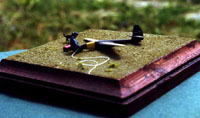 A.M.S.-buster. A.M.S.-buster. When I started considering the model, I had a very tough time tracking down data on the design. In fact, I even sent an e-mail to Slingsby Aviation asking for help. Even they had no data on this product, but they cheerfully requested that I forward anything I discovered about it on to them! 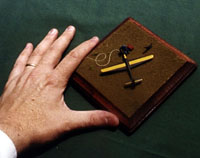 The surface of the metal parts was slightly pitted in spots, so I sanded them with 600 grit sandpaper until the parts were smooth and very shiny. Assembly was completed with superglue; there was a small gap where the horizontal tail joined the Wyvern-like tail, but superglue and traditional sanding and filling procedures fixed that problem. I added tail braces made of styrene strip and wing skids made of metal rod to complete construction. The surface of the metal parts was slightly pitted in spots, so I sanded them with 600 grit sandpaper until the parts were smooth and very shiny. Assembly was completed with superglue; there was a small gap where the horizontal tail joined the Wyvern-like tail, but superglue and traditional sanding and filling procedures fixed that problem. I added tail braces made of styrene strip and wing skids made of metal rod to complete construction.
The model had yellow bands on the tail and nose. Since it was so small, I painted the entire model yellow first, then masked the bands and went over it with dark gray to finish the paint scheme. A clear coat of Varathane was airbrushed on the model to prepare it for the two “Royal Navy” decals on the tail, and a flat coat of Testors dullcote heavily thinned with lacquer thinner completed the model. 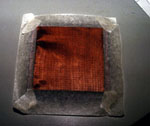 When finished, the model seemed awfully small, so I decided to make a base for it. A pre-cut base measuring five inches by five inches was stained with walnut stain and then sealed with Varathane. The display surface of the base is four by four, which shows just how small the model is! When the base was dry, the edges were masked off and a spray of fixative was applied. A mixture of very fine sand and two tones of Woodland Scenics foam grass was applied to the sticky surface. The excess was tapped off, leaving a very nice 1:72 lawn. A few clumps of larger foam were applied to break up the surface. When finished, the model seemed awfully small, so I decided to make a base for it. A pre-cut base measuring five inches by five inches was stained with walnut stain and then sealed with Varathane. The display surface of the base is four by four, which shows just how small the model is! When the base was dry, the edges were masked off and a spray of fixative was applied. A mixture of very fine sand and two tones of Woodland Scenics foam grass was applied to the sticky surface. The excess was tapped off, leaving a very nice 1:72 lawn. A few clumps of larger foam were applied to break up the surface.
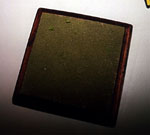 By
itself on the base, the model looked a little lonely, so I dug out some
Prieser figures and started thinking about making a small diorama out
of this model. Now, the figures were from Prieser's Luftwaffe ground crew
set, so some modification was needed. A kneeling bomber crewman looked
like a good possibility, but his head was in the wrong position. I lopped
off his noggin and replaced it with another ground crewman, positioning
the head so that it was “looking” toward the figure’s hands. A bit of
filler was needed at the back of the neck to get the pose right. By
itself on the base, the model looked a little lonely, so I dug out some
Prieser figures and started thinking about making a small diorama out
of this model. Now, the figures were from Prieser's Luftwaffe ground crew
set, so some modification was needed. A kneeling bomber crewman looked
like a good possibility, but his head was in the wrong position. I lopped
off his noggin and replaced it with another ground crewman, positioning
the head so that it was “looking” toward the figure’s hands. A bit of
filler was needed at the back of the neck to get the pose right.
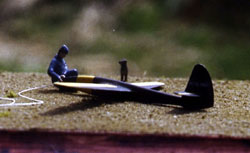 I painted my head-transplanted ‘Erk using Shep Paine’s methods. Although they might seem like overkill in 1:72, they really did work. In this scale, a painted shadow can fool the eye and take the place of missing clothing detail. The face isn’t as expressive a large-scale figure’s would be, but I managed to get eyebrows, eyes and the shadow under the nose and lips. When finished, the figure looked a little like author John Keegan! I painted my head-transplanted ‘Erk using Shep Paine’s methods. Although they might seem like overkill in 1:72, they really did work. In this scale, a painted shadow can fool the eye and take the place of missing clothing detail. The face isn’t as expressive a large-scale figure’s would be, but I managed to get eyebrows, eyes and the shadow under the nose and lips. When finished, the figure looked a little like author John Keegan!
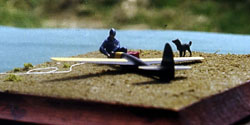 My mechanic was given a set of blue coveralls with some details provided in brass. I spent a long while painting him, mostly because I’ve never done a really good figure and I enjoyed actually getting one right! To help him out in his tasks, I provided him with a tool box from a Hasegawa crew set, painted gloss red (it looks like he bought it at Sears!), and an alert little dog, also from the Preiser set. I discovered that painting a dog was actually more difficult than painting a human, but I kept at it long enough to figure out what colors went where. My mechanic was given a set of blue coveralls with some details provided in brass. I spent a long while painting him, mostly because I’ve never done a really good figure and I enjoyed actually getting one right! To help him out in his tasks, I provided him with a tool box from a Hasegawa crew set, painted gloss red (it looks like he bought it at Sears!), and an alert little dog, also from the Preiser set. I discovered that painting a dog was actually more difficult than painting a human, but I kept at it long enough to figure out what colors went where.
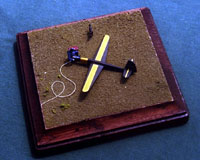 To finish things off, I borrowed a piece of thick thread from my wife’s quilting supplies and glued an end into the right hand of the ‘Erk. The thread—now the tow line for the Type 19—was coiled off to the side and cut off at the edge of the base to suggest that it continued some ways beyond the base to an off-stage Firefly, Tempest or Beaufighter. To finish things off, I borrowed a piece of thick thread from my wife’s quilting supplies and glued an end into the right hand of the ‘Erk. The thread—now the tow line for the Type 19—was coiled off to the side and cut off at the edge of the base to suggest that it continued some ways beyond the base to an off-stage Firefly, Tempest or Beaufighter.
The diorama took me the lesser part of a weekend to finish, squeezed around the laundry, doing the dishes and other sundry housework. A few months later, I decided to take it to the 2000 IPMS/USA Nationals, almost as a 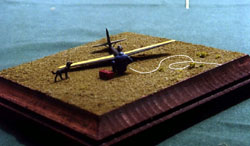 joke. Much to my surprise, my A.M.S.-buster took second place in the small-composition aircraft diorama category! joke. Much to my surprise, my A.M.S.-buster took second place in the small-composition aircraft diorama category! In all, this may be the oddest little model I’ve ever built--certainly the one with the fewest parts, the quickest build time and the most unexpected contest result. Good things come in small packages, they say...! | 


 



  
    |
 The
Slingsby Type 19 was a glider target with a 16-foot wingspan that came
into use in 1942. The last one wasn't shot from the skies until the 1950s,
giving this disposable aircraft a rather long service life. Constructed
out of wood and tissue—non-strategic materials, in other words—the Type
19 gave pilots an airplane-shaped target to fire at and gain experience
that could help when they encountered real opposition. The Type 19 was
towed behind Fireflies, Beaufighters, Tempests and less high-performance
tugs.
The
Slingsby Type 19 was a glider target with a 16-foot wingspan that came
into use in 1942. The last one wasn't shot from the skies until the 1950s,
giving this disposable aircraft a rather long service life. Constructed
out of wood and tissue—non-strategic materials, in other words—the Type
19 gave pilots an airplane-shaped target to fire at and gain experience
that could help when they encountered real opposition. The Type 19 was
towed behind Fireflies, Beaufighters, Tempests and less high-performance
tugs.  Such a small and seldom-seen aircraft seems like an unlikely subject for a kit. In 1991, Blue Rider issued a short-run white-metal 1:72 kit of the Type 19. Seven years later, I found one in the estate sale of beloved San Francisco Bay Area modeler Hugh Silvis, and it looked like a nifty little addition to my collection of odd aircraft.
Such a small and seldom-seen aircraft seems like an unlikely subject for a kit. In 1991, Blue Rider issued a short-run white-metal 1:72 kit of the Type 19. Seven years later, I found one in the estate sale of beloved San Francisco Bay Area modeler Hugh Silvis, and it looked like a nifty little addition to my collection of odd aircraft. A.M.S.-buster.
A.M.S.-buster. The surface of the metal parts was slightly pitted in spots, so I sanded them with 600 grit sandpaper until the parts were smooth and very shiny. Assembly was completed with superglue; there was a small gap where the horizontal tail joined the Wyvern-like tail, but superglue and traditional sanding and filling procedures fixed that problem. I added tail braces made of styrene strip and wing skids made of metal rod to complete construction.
The surface of the metal parts was slightly pitted in spots, so I sanded them with 600 grit sandpaper until the parts were smooth and very shiny. Assembly was completed with superglue; there was a small gap where the horizontal tail joined the Wyvern-like tail, but superglue and traditional sanding and filling procedures fixed that problem. I added tail braces made of styrene strip and wing skids made of metal rod to complete construction.  When finished, the model seemed awfully small, so I decided to make a base for it. A pre-cut base measuring five inches by five inches was stained with walnut stain and then sealed with Varathane. The display surface of the base is four by four, which shows just how small the model is! When the base was dry, the edges were masked off and a spray of fixative was applied. A mixture of very fine sand and two tones of Woodland Scenics foam grass was applied to the sticky surface. The excess was tapped off, leaving a very nice 1:72 lawn. A few clumps of larger foam were applied to break up the surface.
When finished, the model seemed awfully small, so I decided to make a base for it. A pre-cut base measuring five inches by five inches was stained with walnut stain and then sealed with Varathane. The display surface of the base is four by four, which shows just how small the model is! When the base was dry, the edges were masked off and a spray of fixative was applied. A mixture of very fine sand and two tones of Woodland Scenics foam grass was applied to the sticky surface. The excess was tapped off, leaving a very nice 1:72 lawn. A few clumps of larger foam were applied to break up the surface. By
itself on the base, the model looked a little lonely, so I dug out some
Prieser figures and started thinking about making a small diorama out
of this model. Now, the figures were from Prieser's Luftwaffe ground crew
set, so some modification was needed. A kneeling bomber crewman looked
like a good possibility, but his head was in the wrong position. I lopped
off his noggin and replaced it with another ground crewman, positioning
the head so that it was “looking” toward the figure’s hands. A bit of
filler was needed at the back of the neck to get the pose right.
By
itself on the base, the model looked a little lonely, so I dug out some
Prieser figures and started thinking about making a small diorama out
of this model. Now, the figures were from Prieser's Luftwaffe ground crew
set, so some modification was needed. A kneeling bomber crewman looked
like a good possibility, but his head was in the wrong position. I lopped
off his noggin and replaced it with another ground crewman, positioning
the head so that it was “looking” toward the figure’s hands. A bit of
filler was needed at the back of the neck to get the pose right.  I painted my head-transplanted ‘Erk using Shep Paine’s methods. Although they might seem like overkill in 1:72, they really did work. In this scale, a painted shadow can fool the eye and take the place of missing clothing detail. The face isn’t as expressive a large-scale figure’s would be, but I managed to get eyebrows, eyes and the shadow under the nose and lips. When finished, the figure looked a little like author John Keegan!
I painted my head-transplanted ‘Erk using Shep Paine’s methods. Although they might seem like overkill in 1:72, they really did work. In this scale, a painted shadow can fool the eye and take the place of missing clothing detail. The face isn’t as expressive a large-scale figure’s would be, but I managed to get eyebrows, eyes and the shadow under the nose and lips. When finished, the figure looked a little like author John Keegan!  My mechanic was given a set of blue coveralls with some details provided in brass. I spent a long while painting him, mostly because I’ve never done a really good figure and I enjoyed actually getting one right! To help him out in his tasks, I provided him with a tool box from a Hasegawa crew set, painted gloss red (it looks like he bought it at Sears!), and an alert little dog, also from the Preiser set. I discovered that painting a dog was actually more difficult than painting a human, but I kept at it long enough to figure out what colors went where.
My mechanic was given a set of blue coveralls with some details provided in brass. I spent a long while painting him, mostly because I’ve never done a really good figure and I enjoyed actually getting one right! To help him out in his tasks, I provided him with a tool box from a Hasegawa crew set, painted gloss red (it looks like he bought it at Sears!), and an alert little dog, also from the Preiser set. I discovered that painting a dog was actually more difficult than painting a human, but I kept at it long enough to figure out what colors went where.  To finish things off, I borrowed a piece of thick thread from my wife’s quilting supplies and glued an end into the right hand of the ‘Erk. The thread—now the tow line for the Type 19—was coiled off to the side and cut off at the edge of the base to suggest that it continued some ways beyond the base to an off-stage Firefly, Tempest or Beaufighter.
To finish things off, I borrowed a piece of thick thread from my wife’s quilting supplies and glued an end into the right hand of the ‘Erk. The thread—now the tow line for the Type 19—was coiled off to the side and cut off at the edge of the base to suggest that it continued some ways beyond the base to an off-stage Firefly, Tempest or Beaufighter. joke. Much to my surprise, my A.M.S.-buster took second place in the small-composition aircraft diorama category!
joke. Much to my surprise, my A.M.S.-buster took second place in the small-composition aircraft diorama category! 